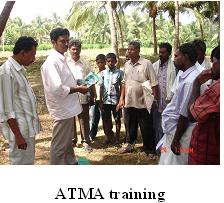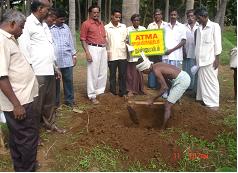Agricultural Technology Management Agency (ATMA)
What is ATMA ?
In order to address the key constraints faced by extension system in the country with respect to reducing capacity of public extension services, its lack of decentralized and demand driven focus, the Innovations in Technology Dissemination component of National Agricultural Technology Project (NATP) was implemented in seven States in the country namely, Andhra Pradesh, Bihar, Himachal Pradesh, Jharkhand, Orissa, Maharashtra and Punjab through four project districts in each State. This component aimed at pilot testing new institutional arrangements for technology dissemination at district level and below in order to move towards an integrated extension delivery. The project process involved adopting bottom up planning procedures for setting the research and extension agency in order to make the technology dissemination farmer driven and farmer accountable. The extension delivery was oriented towards group approach catering to the location specific requirement of the farmers. Gender concerns have been given adequate emphasis under the project. It functions as a registered society at District level and serves as a focal point for integrating research and extension activities and helps in decentralizing the management of agricultural technology transfer.
Click here to view the pilot districts
 
The purpose of NATP's innovation in Technology Dissemination Component is to pilot test new organizational arrangements and operational procedures not merely strengthen the existing extension system. One key concept or goal is to decentralize decision-making to the district level through the creation of Agricultural Technology Management Agency (ATMA). A second goal is to increase farmer input into programme planning and resource allocation, especially at the Block level, and to increase accountability to stakeholders. A third major goal is to increase programme coordination and integration, so that the programme thrust such as farming System innovations, Farmer organization, Technology gaps and Natural Resource Management can be more effectively and efficiently implemented.
The ATMA at district level would be increasingly responsible for all the technology dissemination activities at the district level. It would have linkage with all the line departments, research organizations, non-governmental organizations and agencies associated with agricultural development in the district. Research and Extension units within the project districts such as ZRS or substations, KVKs and the key line Departments of Agriculture, Animal Husbandry, Horticulture and Fisheries etc. would become constituent members or Key stake holders of ATMA. Each Research-Extension(R-E) unit would retain its institutional identity and affiliation but programmes and procedures concerning district-wise R-E activities would be determined by ATMA Governing Board to be implemented by its Management Committee (MC).
Source: http://www.manage.gov.in/atma-shimla/atma.htm
This Scheme was approved on 29th March, 2005. The Scheme has made extension system farmer driven and farmer accountable. 237 Agricultural Technology Management Agency (ATMA) at district level have been set up to operationalise the extension reforms with active participation of farmers / farmer groups, NGOs, Krishi Vigyan Kendras, Panchayati Raj Institutions and other Stakeholder operating at district level and below. The release of funds are based on Strategic Research and Extension plan (SEWP)/ State Extension Work Plans (SEWPs) prepared by the State Governments. State level Extension Plans have been developed keeping in mind the strategic extension needs of the farmers. 252 districts across all the States/UTs in the country were covered under the scheme during the 10th Plan.
Top
Objectives :
The objectives of ATMA are
- To strengthen research – extension – farmer linkages
- To provide an effective mechanism for co-ordination and management of activities of different agencies involved in technology adaption / validation and dissemination at the district level and below.
- To increase the quality and type of technologies being disseminated.
- To move towards shared ownership of the agricultural technology system by key shareholders.
- To develop new partnerships with the private institutions including NGOs.
Top
Salient Features of ATMA :
- Creating Farmer Advisory Committee to improve feed back.
- Using NGOs to organize farmers.
- Encouraging private sector involvement in technology transfer.
- Validation and refining technologies through research units in the district.
- Bottom up planning procedure.
- Increased use of Information Technology (ARIS, WWW)
- In-service training to increase staff competence.
- Developing new Public-Private partnerships.
- Formation and strengthening of farmer's interest group
Top
Funding :
The scheme is suppported by the Central Government. The funding pattern is 90% by the central Government and 10% by the state government. The 10% state’s share shall consist of cash contribution of the State, beneficiary contribution or the contribution of other non-governmental organizations
Allocation of funds :
The entire X Plan outlay (Rs.226.07 crores) for the scheme shall be utilized for activities to be implemented by States/ districts. The decision on use of funds will be taken at 3 levels namely – Centre, State and District.
An amount of Rs. 167.56 crores amounting to 77.53% has been allocated for district level programmes.
An amount of Rs. 22.15 crores amounting to 10.25% has been allocated for State level programmes.
An amount of Rs. 26.41 crores amounting to 12.22% shall be available under the control of the Government of India. This amount shall be utilized for innovative activities to be approved by the Government of India. However, implementation of these activities will be done by States/districts.
OPERATIONALIZING FARM SCHOOL AT BLOCK / GRAM PANCHAYAT LEVEL - COST NORMS/ CEILINGS |
| S.No |
At Farm School (Block /GP Level) |
Rupees |
1 |
Frontline demonstration at Farm School on a maximum area of 2.5 acre @ Rs.4000/- per acre. |
10,000 |
2 |
One-time grant towards logistics support to Farm School |
5,000 |
3 |
Contingency |
2,500 |
4 |
IPM Kit to 25 Farm School trainees @ Rs. 200/- per kit. |
5,000 |
5 |
Details of interactions / training at Farm School |
|
|
(a) Honorarium for maximum two external trainer for maximum 6 visit @ maximum of Rs.250 per visit per trainer |
3,000 |
|
(b) Travel expenses for maximum two external trainer for maximum 6 visits @ maximum of Rs.150 per trainer per visit |
1,800 |
|
(c) Food expenses for 28 participants @ Rs.30 per participant per day for 6 events. |
5,040 |
|
(d) Printed literature @ Rs.50 per participant for 28 participants and trainers |
1,400 |
|
Total : |
33,740 |
6 |
Maximum service charge to achiever farmer/Implementing agency running the Farm School, as per decision of GB, ATMA |
3,374 |
7 |
Training of achiever farmer |
8500 |
8 |
Exposure Visit of achiever farmer |
4800 |
|
Grand Total : |
50,414 |
|
|
|
NOTES |
(i) |
Unit cost ceiling for FLDs at Sl. No.1 is as per norms approved in the Cafeteria. |
(ii) |
Cost of IPM Kit at Sl. No. 4 is similar to cost norms of FFS on IPM. |
(iii) |
Achiever Farmer hosting the Farm School would not be eligible for honorarium. |
(iv) |
Maximum Service Charge at Sl. No. 6 above is as per existing approval under the scheme. |
(v) |
Achiever Farmer hosting the Farm School would qualify as Extension Functionary belonging to the non-governmental sector. |
(vi) |
Training of Achiever Farmer at Sl. No. 7 above is as per norms approved in the Cafeteria. (As per Activity A-2 of Cafeteria - Rs.650 per day + admissible TA/ DA. Cost calculation is on the basis of average 10 days, i.e., Rs.6,500/- for training and Rs.2,000/- for travel expenses) |
(vii) |
Exposure Visit of achiever farmer at Sl. No. 8 above is as per norms approved in the Cafeteria (as per Activity A.3 - Rs.1800 @ Rs.200/- per day for maximum 9 days and Rs.3000/- towards admissible TA/ DA). |
(viii) |
Trainees at Farm School would preferably be leaders of Commodity Interest Groups (CIGs) on whose field Field Demonstration would have been supported under the Scheme. |
(ix) |
If trainees are farmers and not Commodity Interest Groups (CIG) leaders, they should be chosen preferably by the Gram Sabha. |
(x) |
Trainees would bear their own travel expenses, which would suffice as their beneficiary contribution to the activity. |
(xi) |
Maximum number of days for ineraction/ training at Farm School may include a pre-sowing and post-harvest stages as well. It may be decided by ATMA GB at the time of its approval. Also, IDWG, Chairman may, at his discretion, change the total number of days for interaction/ training at Farm School. |
(xii) |
Ceiling for individual items of cost as Sl.1 to 8 above will not be exceeded. |
Top
Beneficiaries |
Individual,Community,Women,Farmers/ Farm Women groups |
Benefits |
Exposure visit, Melas/ Fairs,Empowerment of farmers and farm women groups, Rewards and Incentives |
Details |
Farmers/ Farm Women Interest groups are given training for demand driven production and marketing of farm produce. Rewards and incentives are given to the best performing groups |
|
